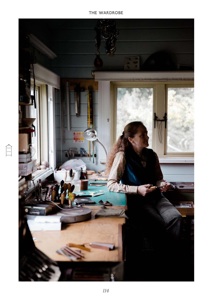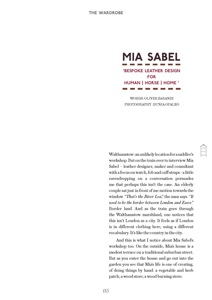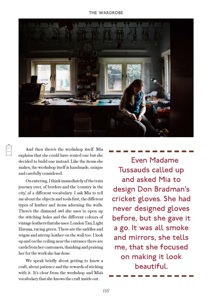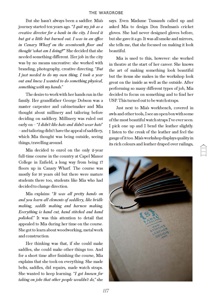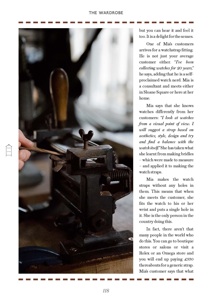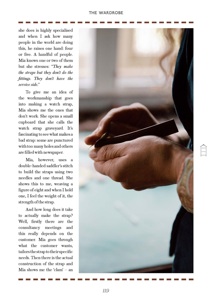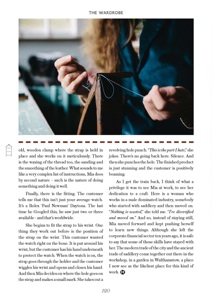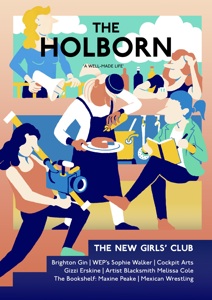
News

The Holborn Issue 6
16 November 2016


Mia is used to this, however: she worked in theatre at the start of her career. She knows the art of making something look beautiful but the items she makes in the workshop look great on the inside as well as the outside. After performing so many different types of job, Mia decided to focus on something and to find her USP. This turned out to be watch straps.
Just next to Mia’s workbench, covered in awls and other tools, I see an open box with some of the most beautiful watch straps I’ve ever seen. I pick one up and I bend the leather slightly. I listen to the creak of the leather and feel the gauge of it too. Mia’s workshop displays quality in its rich colours and leather draped over railings, but you can hear it and feel it too. It is a delight for the senses.
One of Mia’s customers arrives for a watchstrap fitting. He is not just your average customer either. “I’ve been collecting watches for 20 years,” he says, adding that he is a selfproclaimed watch nerd. Mia is a consultant and meets either in Sloane Square or here at her home.
Mia says that she knows watches differently from her customers: “I look at watches from a visual point of view. I will suggest a strap based on aesthetics, style, design and try and find a balance with the watch itself.” She has taken what she learnt from making bridles – which were made to measure – and applied it to making the watch straps.
Mia makes the watch straps without any holes in them. This means that when she meets the customer, she fits the watch to his or her wrist and puts a single hole in it. She is the only person in the country doing this.
In fact, there aren’t that many people in the world who do this. You can go to boutique stores or salons or visit a Rolex or an Omega store and you will end up paying £350 thereabouts for a generic strap. Mia’s customer says that what she does is highly specialised and when I ask how many people in the world are doing this, he raises one hand: four or five. A handful of people. Mia knows one or two of them but she stresses: “They make the straps but they don’t do the fittings. They don’t have the service side.”
To give me an idea of the workmanship that goes into making a watch strap, Mia shows me the ones that don’t work. She opens a small cupboard that she calls the watch strap graveyard. It’s fascinating to see what makes a bad strap: some are punctured with too many holes and others are filled with newspaper.
Mia, however, uses a double-handed saddler’s stitch to build the straps using two needles and one thread. She shows this to me, weaving a figure of eight and when I hold one, I feel the weight of it, the strength of the strap.
And how long does it take to actually make the strap? Well, firstly there are the consultancy meetings and this really depends on the customer. Mia goes through what the customer wants, tailors the strap to their specific needs. Then there is the actual construction of the strap and Mia shows me the ‘clam’ – an old, wooden clamp where the strap is held in place and she works on it meticulously. There is the waxing of the thread too, the sanding and the smoothing of the leather. What sounds to me like a very complex list of instructions, Mia does by second nature – such is the nature of doing something and doing it well.
Finally, there is the fitting. The customer tells me that this isn’t just your average watch. It’s a Rolex ‘Paul Newman’ Daytona. The last time he Googled this, he saw just two or three available - and that’s worldwide.
She begins to fit the strap to his wrist. One thing they work out before is the position of the strap on the wrist. This customer wanted the watch right on the bone. It is put around his wrist, but the customer has his hand underneath to protect the watch. When the watch is on, the strap goes through the holder and the customer wiggles his wrist and opens and closes his hand. And then Mia decides on where the hole goes on the strap and makes a small mark. She takes out a revolving hole punch. “This is the part I hate,” she jokes. There’s no going back here. Silence. And then she punches the hole. The finished product is just stunning and the customer is positively beaming.
As I get the train back, I think of what a privilege it was to see Mia at work, to see her dedication to a craft. Here is a woman who works in a male dominated industry, somebody who started with saddlery and then moved on. “Nothing is wasted,” she told me. “I’ve diversified and moved on.” And so, instead of staying still, Mia moved forward and kept pushing herself to learn new things. Although she left the corporate financial sector ten years ago, it is safe to say that some of those skills have stayed with her. The modern trade of the city and the ancient trade of saddlery come together out there in the workshop, in a garden in Walthamstow, a place I now see as the likeliest place for this kind of work.
MIA SABEL – ‘Bespoke Leather Design For Human | Horse | Home’
Words: OLIVER ZARANDI
Photography: DUNJA OPALKO
Walthamstow: an unlikely location for a saddler’s workshop. But on the train over to interview Mia Sabel – leather designer, maker and consultant with a focus on watch, fob and cuff straps – a little eavesdropping on a conversation persuades me that perhaps this isn’t the case. An elderly couple sat just in front of me motion towards the window. “That’s the River Lea,” the man says. “It used to be the border between London and Essex.” Border land. And as the train goes through the Walthamstow marshland, one notices that this isn’t London as a city. It feels as if London is in different clothing here, using a different vocabulary. It’s like the country in the city.
And this is what I notice about Mia Sabel’s workshop too. On the outside, Mia’s house is a modest terrace on a traditional suburban street. But as you enter the house and go out into the garden you see that Mia’s life is one of creating, of doing things by hand: a vegetable and herb patch; a wood store; a wood burning stove.
And then there’s the workshop itself. Mia explains that she could have rented one but she decided to build one instead. Like the items she makes, the workshop itself is handmade, unique and carefully considered.
On entering, I think immediately of the train journey over, of borders and the ‘country in the city,’ of a different vocabulary. I ask Mia to tell me about the objects and tools first, the different types of leather and items adorning the walls. There’s the diamond awl she uses to open up the stitching holes and the different colours of vintage leathers that she uses: London Tan, Light Havana, racing green. There are the saddles and reigns and stirrup leather on the wall too. I look up and on the ceiling near the entrance there are cards from her customers, thanking and praising her for the work she has done.
We speak briefly about getting to know a craft, about patience and the rewards of sticking with it. It’s clear from the workshop and Mia’s vocabulary that she knows the craft inside out.
Even Madame Tussauds called up and asked Mia to design Don Bradman’s cricket gloves. She had never designed gloves before, but she gave it a go. It was all smoke and mirrors, she tells me, that she focused on making it look beautiful.
But she hasn’t always been a saddler. Mia’s journey started ten years ago. “I quit my job as a creative director for a bank in the city. I loved it but got a little but burned out. I was in an office in Canary Wharf on the seventeenth floor and thought ‘what am I doing?’” She decided that she needed something different. Her job in the city was by no means uncreative: she worked with branding, photography, creative directing. “But I just needed to do my own thing. I took a year out and knew I wanted to do something physical, something with my hands.”
The desire to work with her hands ran in the family. Her grandfather George Dobson was a master carpenter and cabinetmaker and Mia thought about millinery and tailoring before deciding on saddlery. Millinery was ruled out early on – “I didn’t like hats and didn’t wear hats” – and tailoring didn’t have the appeal of saddlery, which Mia thought was being outside, seeing things, travelling around.
Mia decided to enrol on the only 2-year
full-time course in the country at Capel Manor College in Enfield, a long way from being 17 floors up in Canary Wharf. The course was mostly for 16 years old but there were mature students there too, students like Mia who had decided to change direction.
Mia explains: “It was all pretty hands on and you learn all elements of saddlery, like bridle making, saddle making and harness making. Everything is hand cut, hand stitched and hand polished.” It was this attention to detail that appealed to Mia during her time on the course. She got to learn about woodworking, metal work and construction.
Her thinking was that, if she could make saddles, she could make other things too. And for a short time after finishing the course, Mia explains that she took on everything. She made belts, saddles, did repairs, made watch straps. She wanted to keep learning. “I got known for taking on jobs that other people wouldn’t do,” she says. Even Madame Tussauds called up and asked Mia to design Don Bradman’s cricket gloves. She had never designed gloves before, but she gave it a go. It was all smoke and mirrors, she tells me, that she focused on making it look beautiful.
